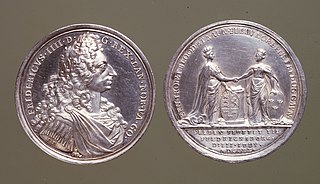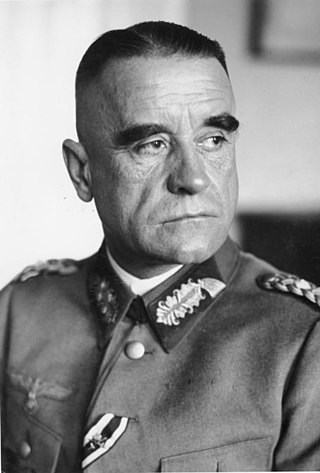Related Research Articles

The flag of Europe or European flag consists of twelve golden stars forming a circle on a blue field. It is the official flag of the European Union. It was designed and adopted in 1955 by the Council of Europe (CoE) as a symbol for the whole of Europe.
The Treaties of Stockholm were two treaties signed in 1719 and 1720 that ended the war between Sweden and an alliance of Hanover and Prussia.

The Treaty of Frederiksborg was a treaty signed at Frederiksborg Castle, Zealand, on 3 July 1720, ending the Great Northern War between Denmark–Norway and Sweden.

The Gorgon is a 1964 British horror film directed by Terence Fisher and starring Christopher Lee, Peter Cushing, Richard Pasco and Barbara Shelley. The screenplay was by John Gilling and Anthony Nelson Keys. It was produced by Keys for Hammer Films.
Louis V, called the Brandenburger, a member of the House of Wittelsbach, ruled as Margrave of Brandenburg from 1323 to 1351 and as Duke of Bavaria from 1347 until his death. From 1342 he also was co-ruling Count of Tyrol by his marriage with the Meinhardiner countess Margaret.

Heitz Cellar is a California wine producer located within Napa Valley east of the town of St. Helena. An early modern era Napa Valley presence and pioneering exponent of French oak, the estate enjoys a historical renown with the success of its Martha's Vineyard Cabernet Sauvignon, and has also been described as a "master of Grignolino".

Hara Arena was a 5,500-seat multi-purpose arena located in the Trotwood, Ohio suburb of Dayton. The facility began as a ballroom in 1957, added an arena in 1964 and grew to a six-building complex which closed in August 2016.

The Treaty of Stettin of 4 May 1653 settled a dispute between Brandenburg and Sweden, who both claimed succession in the Duchy of Pomerania after the extinction of the local House of Pomerania during the Thirty Years' War. Brandenburg's claims were based on the Treaty of Grimnitz (1529), while Sweden's claims were based on the Treaty of Stettin (1630). The parties had agreed on a partition of the Swedish-held duchy in the Peace of Westphalia (1648), and with the Treaty of Stettin determined the actual border between the partitions. Western Pomerania became Swedish Pomerania, Farther Pomerania became Brandenburgian Pomerania.

The Treaty of Stettin or Alliance of Stettin was the legal framework for the occupation of the Duchy of Pomerania by the Swedish Empire during the Thirty Years' War. Concluded on 25 August (O.S.) or 4 September 1630 (N.S.), it was predated to 10 July (O.S.) or 20 July 1630 (N.S.), the date of the Swedish Landing. Sweden assumed military control, and used the Pomeranian bridgehead for campaigns into Central and Southern Germany. After the death of the last Pomeranian duke in 1637, forces of the Holy Roman Empire invaded Pomerania to enforce Brandenburg's claims on succession, but they were defeated by Sweden in the ensuing battles. Some of the Pomeranian nobility had changed sides and supported Brandenburg. By the end of the war, the treaty was superseded by the Peace of Westphalia (1648) and the subsequent Treaty of Stettin (1653), when Pomerania was partitioned into a western, Swedish part, and an eastern, Brandenburgian part.
Medieval Pomerania was converted from Slavic paganism to Christianity under Bolesław III Wrymouth, by bishop Otto of Bamberg in 1124 and 1128, and in 1168 by Absalon.

The capitulation of Franzburg was a treaty providing for the capitulation of the Duchy of Pomerania to the forces of the Holy Roman Empire during the Thirty Years' War. It was signed on 10 November (O.S.) or 20 November (N.S.) 1627 by Bogislaw XIV, Duke of Pomerania, and Hans Georg von Arnim, commander in chief of an occupation force belonging to the army of Ferdinand II, Holy Roman Emperor, led by Albrecht von Wallenstein. While the terms of the capitulation were unfavourable for the Duchy of Pomerania already, occupation became even more burdensome when the occupation force did not adhere to the restrictions outlined in Franzburg. Stralsund resisted with Danish, Swedish and Scottish support, another Danish intervention failed. Imperial occupation lasted until Swedish forces invaded in 1630, and subsequently cleared all of the Duchy of Pomerania of imperial forces until 1631.
The Treaty of Soldin was signed on 21 January 1466 at Soldin by the Brandenburgian elector Frederick II and the Pomeranian dukes Eric II and Wartislaw X. It was mediated by the town of Stettin. The treaty temporarily settled a conflict about the succession of Otto III, Duke of Pomerania, who had died without issue: Emperor Frederick III, elector Frederick II as well as Eric II and Wartislaw X of Pomerania claimed to be the rightful heir of Otto's share of the Duchy of Pomerania.
Starting in the 12th century, the Margraviate, later Electorate, of Brandenburg was in conflict with the neighboring Duchy of Pomerania over frontier territories claimed by them both, and over the status of the Pomeranian duchy, which Brandenburg claimed as a fief, whereas Pomerania claimed Imperial immediacy. The conflict frequently turned into open war, and despite occasional success, none of the parties prevailed permanently until the House of Pomerania died out in 1637. Brandenburg would by then have naturally have prevailed, but this was hindered by the contemporary Swedish occupation of Pomerania, and the conflict continued between Sweden and Brandenburg-Prussia until 1815, when Prussia incorporated Swedish Pomerania into her Province of Pomerania.

The Treaty or Peace of Saint-Germain-en-Laye of 19 June (OS) or 29 June (NS) 1679 was a peace treaty between France and the Electorate of Brandenburg. It restored to France's ally Sweden her dominions Bremen-Verden and Swedish Pomerania, lost to Brandenburg in the Scanian War. Sweden ratified the treaty on 28 July 1679.

The Treaty of Pyritz settled claims of the House of Pomerania and the House of Hohenzollern regarding the legal status and succession in the Duchy of Pomerania on 26 and 28 March 1493. John Cicero, Elector of Brandenburg of the Hohenzollern renounced the Electorate of Brandenburg's claims to hold the Pomeranian duchy as a fief on 26 March in Pyritz. In turn, Bogislaw X, Duke of Pomerania acknowledged Brandenburgian succession in his duchy in case of the extinction of his dynasty on 28 March in Königsberg. The treaty was the most important achievement of Bogislaw X's foreign policy. It was confirmed and amended when a final settlement between the two houses was reached in the Treaty of Grimnitz in 1529.

The Treaty of Grimnitz was the final settlement of a long-standing dispute between the House of Pomerania and the House of Hohenzollern regarding the legal status and succession in the Duchy of Pomerania. It renewed and amended the Treaty of Pyritz of 1493.

The siege of Stralsund lasted from 24 July to 24 August, 1807, and saw troops from the First French Empire twice attempt to capture the port city from Lieutenant General Hans Henric von Essen's 15,000-man Swedish garrison. Early that year, Marshal Édouard Adolphe Casimir Joseph Mortier blockaded the city for two months before he was called elsewhere. In his absence, the Swedes drove back the inferior blockading force. After Mortier returned and pushed Essen's troops back in turn, the two sides quickly concluded an armistice. The truce was later repudiated by King Gustav IV Adolf of Sweden, and Marshal Guillaume Marie Anne Brune then led 40,000 French, German, Spanish, Italian and Dutch soldiers against the fortress. Fearfully outnumbered, the Swedes abandoned the Baltic Sea port of Stralsund to the Franco-Allies in the action during the War of the Fourth Coalition, part of the Napoleonic Wars. As a consequence, Sweden also lost the nearby island of Rügen.

Walter Heitz was a German general (Generaloberst) in the Wehrmacht during World War II. He served as President of the Reich Military Court and commanded part of the 6th Army in the Battle of Stalingrad.
The Treaty of Pyzdry was signed on 2 November 1390 between Władysław II Jagiełło, king of Poland and Wartislaw VII of Pomerania-Stolp. The treaty, signed in Pyzdry, contained an oath of vassalage of Wartislaw to Jagiełło, the obligation to support the latter in the Polish-Teutonic War, and mutual trade alleviations for Pomeranian and Polish merchants. Wartislaw VII, who with his brothers was allied with the Teutonic Order before, received the Polish castellany of Nakło and probably some adjacent areas as a fief.
References
- 1 2 3 Heitz (1995), p.157
- 1 2 Heitz (1995), p.162
- 1 2 Herrmann (1985), pp. 394ff
- 1 2 3 4 Heitz (1995), p.163
- 1 2 3 4 Heitz (1995), p.164
- 1 2 3 4 5 6 7 Heitz (1995), p.165
- 1 2 3 4 5 Buchholz (1999), pp. 34, 35
- 1 2 3 4 Heitz (1995), p.166
- 1 2 3 4 5 Heitz (1995), p.167
- 1 2 3 4 Heitz (1995), p.168
- ↑ Heitz (1995), p.169
- 1 2 3 4 Heitz (1995), p.170